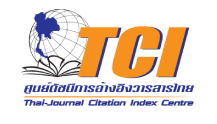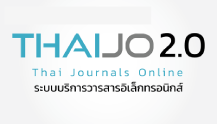Factors Related to Preschoolers’ Snack Consumption Behaviour
Keywords:
SNACKS CONSUMPTION BEHAVIORS PRE-SCHOOL CHILDRENAbstract
Abstract:
Objective: To examine preschoolers’ snack consumption behaviour and its relation
to individual factors (i.e., knowledge of and attitude towards snack consumption, daily
allowance, and nutritional status); family factors (i.e., parents’ occupations and education,
family’s income, and parents’ snack consumption behaviour); and socio-environmental
factors (i.e., access to snack-related information, and the number of snack shops near
the school and home).
Design: Descriptive correlational research.
Methodology: Through stratifed random sampling, a total of 154 pairs of
preschoolers aged 5-6 and their guardians, all living in Muang district, Khonkaen
province, were selected. Data were collected using a questionnaire, an interview, and
nutritional state assessment. The data were analysed using descriptive statistics, Spearman’s
correlation analysis and chi-square test.
Results: The preschoolers’ average scores on snack consumption knowledge,
attitude and behaviour were 67.7%, 39.7% and 53.8%, respectively. The majority of
them consumed snacks more than once a week, the most frequently consumed types of
snacks being crisps and chocolate, and the least frequently consumed being jelly. A
correlation analysis revealed a negative relation between the preschoolers allowances
and their snack consumption behaviour (rs = -.266, p = .001). On the other hand, a
positive relation was found between the preschoolers snack consumption behaviour and
their parents’ (rs = .632, p < .001).
Recommendations: Based on the results, nurses and healthcare staff can apply
the infomation for study on factors predicting consumption, and to developing a programme
that properly promotes snack consumption behaviour of preschoolers, especially
those on high daily allowances.
References
2. Mosuwan L. Dessert and children’s health. In: Sututworawut A, Jongviriyapan N, Tantashewathon S, editors. Nutrition guidline. Bangkok: Pimsow; 2007, 71-104. (In Thai)66
3. Department of Health: Ministry of Health (Thailand). Sugar sweetness in dessert, beverage, milk, for children Health [serial online ] 2011 May [cited 2013 May 8];Available from URL: https://www. thaihealth. or.th/partner/books_ rec/29641
4. Wongkongkatep S. Sweet food consumption behaviour and dental caries in pre-school children. Bangkok: Onprintshop; 2007.(In Thai)
5. Anderson PM, Butcher KF, Levine PB. Economic perspective on children obesity. Eco Per2003; 3:30-2.
6. Huerta M, Bibi H, Haviv J, Scharf S, Gdalevich. Parental smoking and education as determinants of overweight in Israeli children. Pre Chronic Dis 2006; 3(2): 1-9.
7. Bronfenbrenner U. The Ecological perspective of development [serial online ] 2010 Jan [cited 2010 January 12]; Available from: URL: https://faculty. weber.edu/tlday/human.development/ecological.htm
8. Isarapun P. Consumption of crispy snacks in child center at KhaoRhang District Administration Organization in amphur-muang, Ratchaburi province. Ratchaburi; 2008. (In Thai)
9. Polit DF, Beck CT. Nursing research: Generating and assessing evidence for nursing practice. 9th ed. Philadelphia: Wolters Kluwer Lippincott William & Wilkins; 2012.
10. Beathong S. Factors associated with food behavior for snacks and sweet beverages among primary school students in amphur-muang, NakhonPatomprovince. [dissertation]. NakhonPathom: MahidolUniv; 2007. (In Thai)
11. Nutrition Division,Department of Health: Ministry of Public Health. Weight height comparison chart and nutrition indicators of Thai People aged 1 to 19 years. Nonthaburi:Printing Agriculture Cooperatives of Thailand; 2000. (In Thai)
12. Wisitcharean K.Factors associated with nutritional status in pre-school children in Nakhon Nayok Province. [dissertation]. Nakhon Pathom: Mahidol Univ; 2007.(In Thai)
13. Songkhla Consumer Organization Network. Consumption snack behavior in children of the view of the parents
[serial online] 2010Oct [cited 2010 October 22].Available from: URL: https://eportfolio.hu.ac.th/ research/images/stories/snack.doc
14. Hauwdcharean G, Chareanmanop J. Data collection of energy, sugar, salt and fatty ready made meals.
[dissertation]. Nakhon Pathom: Mahidol Univ; 2009.(In Thai)
15. Wungrath J. Food consumption behavior of pre-school children whose parents working in other places. J Pub Health Dev 2011; 9(3), 312-23.
16. Sangdadchart C.Critical thinking development with snack consumption in school children in SamutPrakarn
Province. [dissertation]. Nakhon Pathom: Mahidol Univ; 2010. (in Thai)
17. Khotpukdee N. Child development in Ruangdaraganon.N et al, editors. Handbook of development and child
behavior. Bangkok: Holistic publishing; 2007. p.359-93.
18. Offce of the Basic Education Commission. Policies and guidelines for admission of students under the Offce
of the Basic Education Commission [serial online] 2010 Feb [cited 2010 Febuary 6]. Available from: URL: https://210.246.188.60/Rubstudent_ web54/
19. Boyer LE et al. Shape of snack food does not predict snack intake in a sample of preschoolers: a cross-over
study. IJBNPA 2012; 9: 90-4.
20. Salvy SJ, Kieffer E, Epstein LH. Effect of social context on overweight and normal-weight children’s food selection.
NIH Public Access 2008; 9(2): 190-196.
20. Kleef EV et al. Healthy snack at the checkout counter: A lab and feld study on the impact of shelf arrangement and assortment structure on consumer choices.BMC Public Health 2012; 12: 1072-82.






